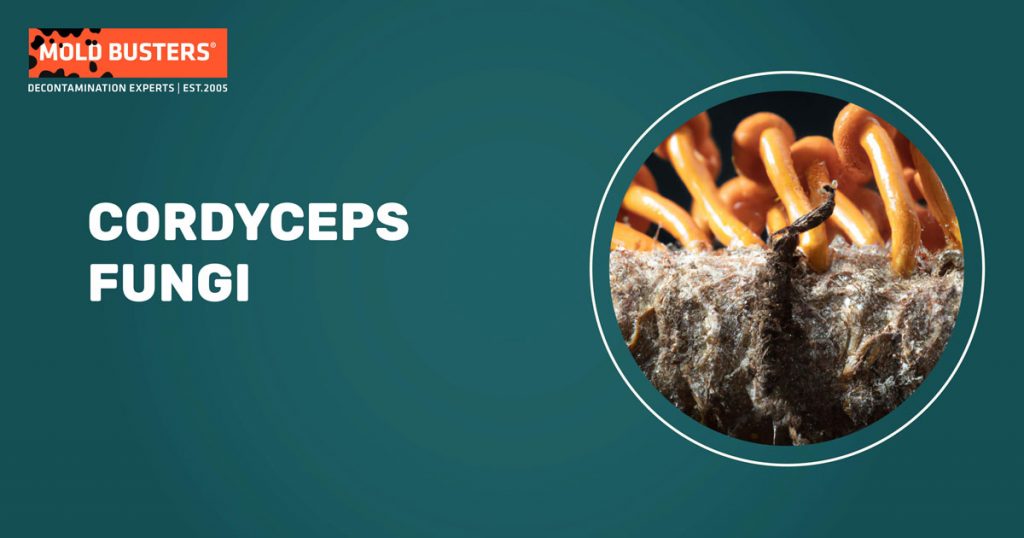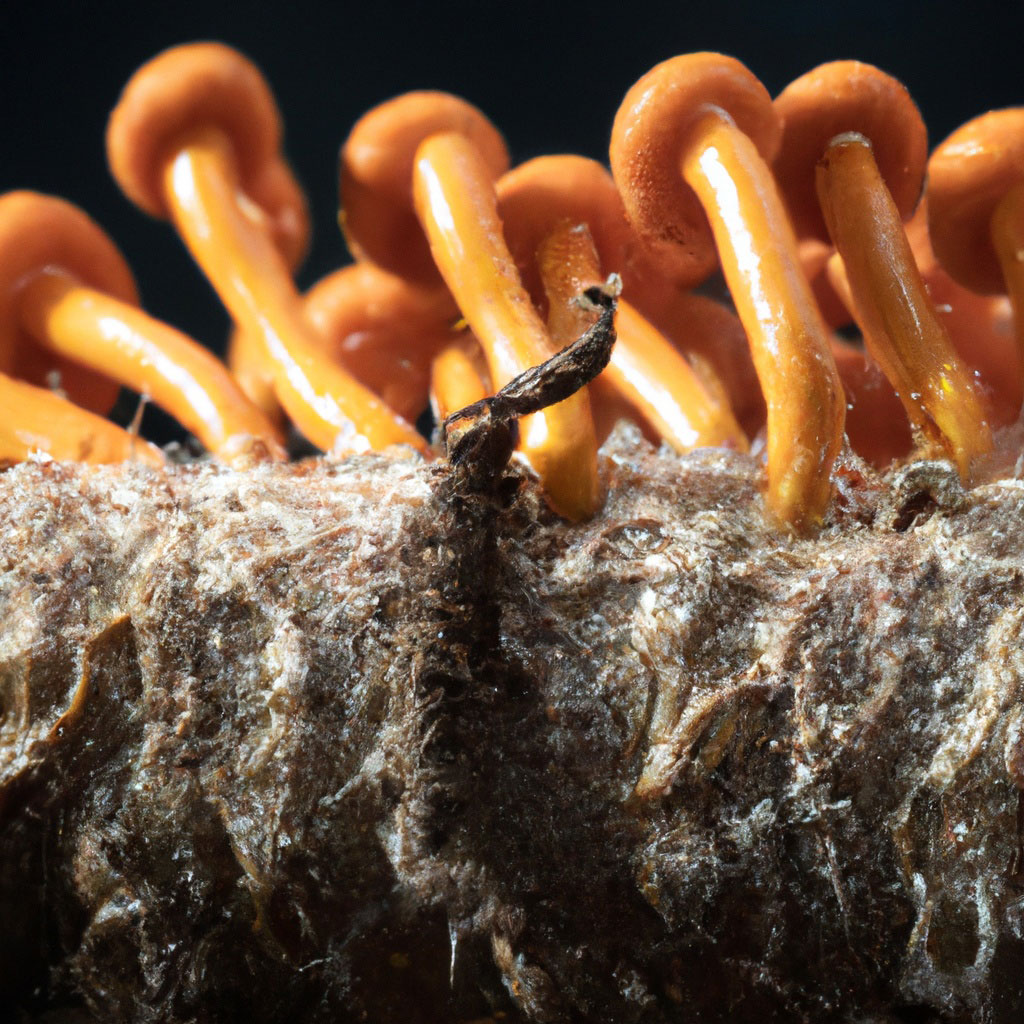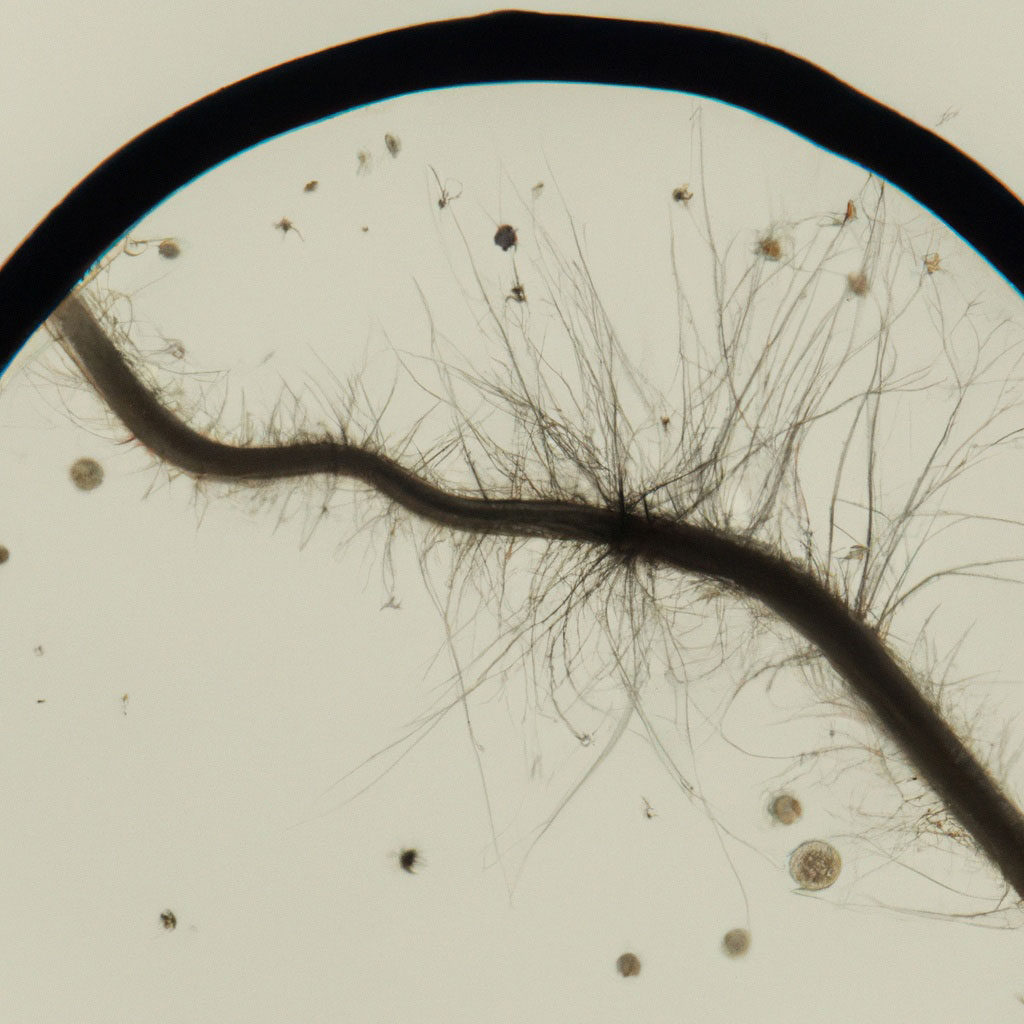Cordyceps fungi are a group of parasitic fungi that grow on insects and other arthropods. These fungi are known for their medicinal properties and have been used for centuries in traditional medicine. In recent years, cordyceps fungi have gained popularity as a health supplement and alternative medicine. In this article, we will explore the various species of cordyceps fungi, their uses, and their potential health benefits.

What are Cordyceps Fungi?
Cordyceps fungi are a group of fungi that belong to the family Ophiocordycipitaceae. These fungi grow on the larvae of various insects and arthropods, such as caterpillars, beetles, and spiders. The fungus infects the host insect, and as it grows, it replaces the insect’s tissue and eventually sprouts out of the insect’s body.
Cordyceps fungi are commonly found in the mountainous regions of Asia, particularly in Tibet, Bhutan, and Nepal. They have been used in traditional Chinese medicine for centuries to treat a variety of ailments, such as fatigue, kidney disease, and respiratory infections.
Anatomy and life cycle of Cordyceps
Cordyceps is a type of fungi that belongs to the Ascomycota phylum. There are over 400 known species of Cordyceps, which can be found all around the world. These fungi are known for their unique life cycle, which involves infecting and killing insects.
Anatomy of Cordyceps:
The Cordyceps fungi have a unique structure that is composed of two parts: the stroma and the fruiting body. The stroma is the main body of the fungus and it is usually buried in the soil or substrate. The fruiting body, on the other hand, is the visible part of the fungus that emerges above the ground. The fruiting body is responsible for producing spores, which are used to reproduce.
Life cycle of Cordyceps:
The life cycle of Cordyceps begins with spores, which are dispersed by wind or other means. When a spore lands on a suitable substrate, it germinates and begins to grow. As the fungus grows, it produces a network of thread-like structures called hyphae. The hyphae then penetrate the body of an insect, usually a caterpillar or a beetle.
Once inside the insect, the Cordyceps fungus begins to grow rapidly, consuming the insect’s tissues and organs. The fungus then produces a stalk-like structure, which emerges from the insect’s body and grows upwards towards the surface. This structure is called the fruiting body and it is the part of the fungus that is visible to the naked eye.
As the fruiting body grows, it produces spores, which are released into the environment. These spores can then infect new insects, continuing the life cycle of the Cordyceps fungus.
The anatomy and life cycle of Cordyceps are unique and fascinating. These fungi have adapted to infect and consume insects, using them as a substrate for growth and reproduction. Understanding the life cycle and anatomy of Cordyceps is important for further research into their medicinal properties and potential applications in various fields.
Habitat and natural distribution of Cordyceps
Cordyceps is a type of fungi that can be found in a wide range of habitats and environments around the world. The natural distribution of Cordyceps is quite diverse, with different species of the fungus being found in various regions and climates.
Habitat of Cordyceps:
Cordyceps fungi are commonly found in forests and grasslands, where they grow on soil, decaying plant matter, or insects. Some species of Cordyceps are specifically adapted to grow on insects, and these fungi can be found in areas with high insect populations, such as tropical rainforests.
Natural distribution of Cordyceps:
Cordyceps fungi are distributed throughout the world, but their natural distribution varies depending on the species. Some species of Cordyceps are found in specific regions, while others have a wider distribution. For example, Cordyceps militaris is commonly found in temperate regions of Asia, while Cordyceps sinensis is found in the Himalayan region.
Cordyceps species have also been found in other parts of the world, including North and South America, Europe, and Australia. The distribution of these fungi is often influenced by factors such as climate, vegetation, and insect populations.
In recent years, there has been increased interest in cultivating Cordyceps fungi for medicinal and culinary purposes. This has led to the development of cultivation methods that can be used to grow Cordyceps in controlled environments, regardless of their natural distribution.
Cordyceps is a versatile and adaptable type of fungi that can be found in a variety of habitats and environments around the world. Understanding the natural distribution and habitat of Cordyceps is important for conservation efforts, as well as for the development of cultivation methods that can be used to sustainably produce these fungi.
Types of Cordyceps Fungi – Most Popular Species Explained
There are several species of cordyceps fungi, each with its unique properties and health benefits. Some of the most popular species of cordyceps fungi include:
Cordyceps sinensis
Cordyceps sinensis is one of the most popular and widely used species of cordyceps fungi. It is commonly referred to as “Dong Chong Xia Cao” in Chinese, which translates to “winter worm, summer grass.” This species of cordyceps grows on the larvae of the Himalayan bat moth, and it is predominantly found in the mountains of Tibet and Nepal.

Cordyceps sinensis has been used in traditional Chinese medicine to boost the immune system, improve athletic performance, and treat kidney and respiratory diseases. It is also believed to have anti-aging properties.
Cordyceps militaris
Cordyceps militaris is another popular species of cordyceps fungi. It is commonly found in temperate regions of Asia, such as China, Korea, and Japan. Unlike Cordyceps sinensis, which grows on the larvae of the Himalayan bat moth, Cordyceps militaris grows on the larvae of various insects, including caterpillars and beetles.
Cordyceps militaris is believed to have anti-inflammatory and anti-tumor properties. It is also used to improve cardiovascular health and boost the immune system.
Cordyceps ophioglossoides
Cordyceps ophioglossoides is a species of cordyceps fungi that is found in North America. It grows on the larvae of moths and butterflies and is commonly known as the “eastern moths’ nest fungus.”
Cordyceps ophioglossoides is believed to have antioxidant and anti-inflammatory properties. It is also used to improve cognitive function and alleviate anxiety and depression.
Cordyceps ignota
Cordyceps ignota is a relatively unknown species of Cordyceps that was recently discovered in the forests of Thailand. It is characterized by its unique fruiting body, which is a long, slender stalk with a bulbous tip that contains the spores of the fungus. While Cordyceps ignota is not commonly used in traditional medicine, it has been found to contain bioactive compounds with potential health benefits, including antioxidant and anti-inflammatory properties. Further research is needed to fully understand the potential benefits of Cordyceps ignota and its bioactive compounds.
Cordyceps tiens
Cordyceps tiens is a type of Cordyceps species that is highly valued for its medicinal properties. It is commonly found in the high-altitude regions of China, Tibet, and Nepal, where it grows on the larvae of ghost moths. Cordyceps tiens has been traditionally used in Chinese medicine for thousands of years to treat a variety of ailments, including respiratory disorders, kidney disease, and fatigue. It is believed to have a range of health benefits due to its rich composition of bioactive compounds, including polysaccharides, nucleosides, and cordycepin. Recent studies have also suggested that Cordyceps tiens may have anti-inflammatory, antioxidant, and immunomodulatory effects, further highlighting its potential therapeutic applications.
Importance of studying cordyceps species
Studying Cordyceps species is important for several reasons. Firstly, Cordyceps fungi are known to have a range of potential health benefits, including immunomodulatory, anti-inflammatory, and antioxidant effects, among others. As such, research into these fungi may lead to the development of new treatments for a variety of illnesses and diseases. Secondly, Cordyceps fungi are fascinating organisms with unique life cycles and ecological roles. Understanding their biology and ecology can provide insights into the functioning of ecosystems and the evolution of fungi. Finally, Cordyceps fungi are economically important, with some species being highly valued for their medicinal properties and others having potential applications in agriculture and biotechnology. Therefore, studying Cordyceps species can have both practical and theoretical significance.
Cordyceps Dangers – Can Cordyceps infect humans?
There is currently no evidence to suggest that Cordyceps fungi can infect humans. However, it is important to note that some species of Cordyceps are parasitic and can infect and kill insects, spiders, and other arthropods. Ingesting Cordyceps-infected insects is a traditional practice in some cultures, but it is important to ensure that the insects are properly prepared and that the species of Cordyceps used is safe for consumption.

Cordyceps on Insects
Cordyceps is a type of fungus that is known for its unique parasitic behavior, where it infects and eventually kills insects, arthropods, and other small animals. One of the most famous examples of Cordyceps’ parasitic behavior is the Cordyceps on spiders.
Cordyceps on spider
When a Cordyceps spore lands on a spider, it will germinate and grow into the spider’s body, eventually consuming its host from the inside out. The fungus takes over the spider’s brain and nervous system, forcing it to climb to a high point and attach itself to a leaf or branch. The fungus then grows out of the spider’s body in the form of a long stalk that releases spores, which are carried by the wind to infect other insects and continue the cycle.
The parasitic relationship between Cordyceps and insects is not limited to spiders, as the fungus can infect a wide range of insects, including ants, caterpillars, and beetles. Different species of Cordyceps have evolved to target specific types of insects, with some even exhibiting specialized behaviors that allow them to manipulate their host’s behavior for their own benefit.
Cordyceps mycelium

Cordyceps mycelium refers to the vegetative or growing stage of the Cordyceps fungus, which is made up of a network of hyphae or filaments that form a mass of white or yellowish thread-like structures. The mycelium grows underground or inside the host insect, where it obtains nutrients and energy to develop into the fruiting body or the part of the fungus that produces spores.
Cordyceps in ants

Cordyceps is a type of fungus that infects insects, including ants, and uses them as hosts to complete its life cycle. The fungus enters the ant’s body, grows and feeds on its internal tissues, and eventually manipulates its behavior to ensure its own dispersal. The infected ant is compelled to climb to a high vantage point and attach itself to a leaf or stem before dying. The fungus then grows a stalk out of the ant’s head and releases spores to infect other ants below. The study of this fascinating interaction has provided insights into the mechanisms of fungal parasitism and host manipulation.
Cordyceps and “The Last of Us” TV show
Cordyceps plays a significant role in The Last of Us, a TV series adaptation of the popular video game franchise. In the game and the show, a mutant strain of Cordyceps has infected the human population, turning them into aggressive and zombie-like creatures. The story follows the journey of Joel and Ellie, two survivors in this post-apocalyptic world, as they try to find a cure for the infection.
It’s worth noting that the Cordyceps portrayed in the game and show is purely fictional and does not accurately reflect the real-life Cordyceps fungi found in nature. However, the use of Cordyceps as a basis for the game’s infection does add a unique and interesting twist to the post-apocalyptic genre.

Did you know?
The #1 toxic mold type found in homes is the Penicillium/Aspergillus mold group?! Find out more exciting mold stats and facts inside our mold statistics page.
FAQs
Are Cordyceps fungi safe for consumption?
Cordyceps fungi are generally considered safe for consumption when used appropriately. In traditional Chinese medicine, Cordyceps have been used as a medicinal ingredient for centuries, and in recent years they have gained popularity as a dietary supplement due to their potential health benefits.
However, as with any dietary supplement or natural product, it is important to use caution and consult with a healthcare professional before taking Cordyceps supplements, particularly if you have a pre-existing medical condition or are taking medication. Some individuals may also be allergic to Cordyceps or other fungi, and may experience allergic reactions when exposed to them.
It is also important to ensure that you are purchasing high-quality Cordyceps supplements from a reputable source, as some products on the market may be contaminated or mislabeled. By taking appropriate precautions and using Cordyceps supplements as directed, you can enjoy their potential health benefits with minimal risk.
How are Cordyceps fungi grown?
Cordyceps fungi can be grown through a process called fermentation. The process involves growing the fungi in a nutrient-rich environment under controlled conditions, such as temperature, humidity, and light.
The cultivation of Cordyceps fungi typically involves growing the mycelium, or vegetative part of the fungus, on a substrate such as rice, barley, or oats. Once the mycelium has fully colonized the substrate, the resulting culture can be harvested and processed into various forms, such as powders or extracts, for use in supplements and other products.
The cultivation of Cordyceps fungi can be a complex process that requires specialized equipment and expertise and is typically carried out by professional growers in commercial settings. However, with the growing popularity of Cordyceps supplements, some home growers have also started experimenting with cultivating the fungi on a smaller scale using DIY methods and kits.
Are there any scientific studies on the benefits of Cordyceps fungi?
Yes, there have been many scientific studies conducted on the potential benefits of Cordyceps fungi. Some of the most well-researched areas include the fungi’s potential effects on the immune system, energy metabolism, and exercise performance.
For example, studies have suggested that Cordyceps may help to modulate the immune system by stimulating the activity of certain immune cells and enhancing the production of cytokines, which are signaling molecules that play a key role in immune function.
In terms of energy metabolism, research has indicated that Cordyceps may have an impact on cellular energy production by increasing the activity of enzymes involved in the production of adenosine triphosphate (ATP), the main source of energy for the body’s cells.
Additionally, studies have investigated the potential effects of Cordyceps on exercise performance, with some suggesting that the fungi may help to increase endurance and reduce fatigue during physical activity.
While the research on Cordyceps is still ongoing and more studies are needed to fully understand its potential benefits, the existing evidence suggests that the fungi may have a range of therapeutic properties that could make it a valuable addition to the field of natural medicine.
Conclusion
Cordyceps fungi are a group of parasitic fungi that grow on insects and other arthropods. They have been used in traditional Chinese medicine for centuries to treat a variety of ailments. Cordyceps fungi are believed to have several health benefits, including boosting the immune system, improving athletic performance, and treating respiratory infections. However, it is important to consult a healthcare provider before taking cordyceps fungi, as they can interact with certain medications and may not be suitable for everyone.
References
- Li, S. P., Li, P., Dong, T. T., & Tsim, K. W. (2003). Anti-oxidation activity of different types of natural Cordyceps sinensis and cultured Cordyceps mycelia. Phytomedicine, 10(6-7), 479-481.
- Sung, G. H., Hywel-Jones, N. L., Sung, J. M., & Luangsa-ard, J. J. (2007). Phylogenetic classification of Cordyceps and the clavicipitaceous fungi. Studies in Mycology, 57, 5-59.
- Wang, X., Yao, Y., Zeng, Y., Wang, L., & Xiao, Y. (2019). Review on the isolation, identification, and bioactivities of Cordyceps fungi. BioMed Research International, 2019, 1-18.
- Shrestha, B., & Sung, J. M. (2019). Medicinal mushrooms and their bioactive compounds for cancer prevention and treatment. Medicines, 6(2), 1-21.
- Xu, J., Ji, W., Li, Y., Li, Y., Chen, S., & Yu, H. (2018). Phytochemical and pharmacological studies on Cordyceps: a systematic review. Chinese Medicine, 13(1), 1-25.
- Zhu, J. S., & Rippe, J. (2005). CordyMax Cs-4: A proprietary standardised extract of Cordyceps sinensis mushrooms for enhancing aerobic exercise performance in healthy young adults. Chinese journal of integrative medicine, 11(3), 201-207.
- Huang, Y.L., Leu, S.F., Liu, B.C. et al. “Cordycepin enhances radiosensitivity in oral squamous carcinoma cells by inducing autophagy and apoptosis through cell cycle arrest.” Int J Mol Sci. (2018) https://www.ncbi.nlm.nih.gov/pmc/articles/PMC6862293/
- Li, W., Zhou, P., Dai, Y. et al. “Cordyceps sinensis (a traditional Chinese medicine) for kidney transplant recipients.” Cochrane Database Syst Rev. (2015) https://www.ncbi.nlm.nih.gov/pmc/articles/PMC9446485/
- Lee, K., Lee, I.K., Kim, Y. et al. “Cordycepin-enriched Cordyceps militaris induces immunomodulation and tumor growth delay in mouse-derived breast cancer.” Oncol Rep. (2017) https://pubmed.ncbi.nlm.nih.gov/23921598/
- Yang, Z., Shu, W., Chen, X. et al. “Effect of Cordyceps sinensis on renal function of patients with chronic allograft nephropathy.” Urology. (2004) https://pubmed.ncbi.nlm.nih.gov/21335937/

Get Special Gift: Industry-Standard Mold Removal Guidelines
Download the industry-standard guidelines that Mold Busters use in their own mold removal services, including news, tips and special offers:

Written by:
John Ward
Account Executive
Mold Busters
Fact checked by:
Michael Golubev
General Manager
Mold Busters
